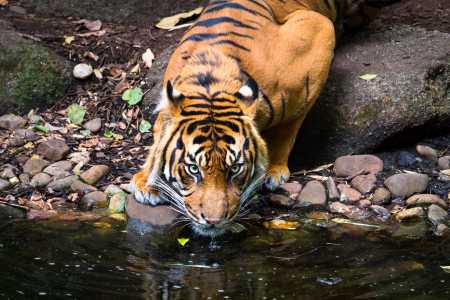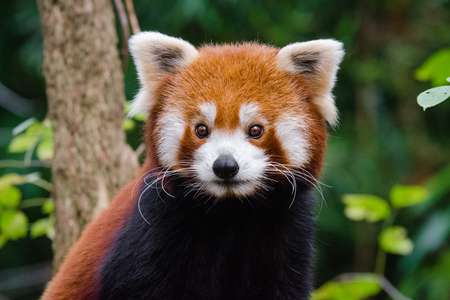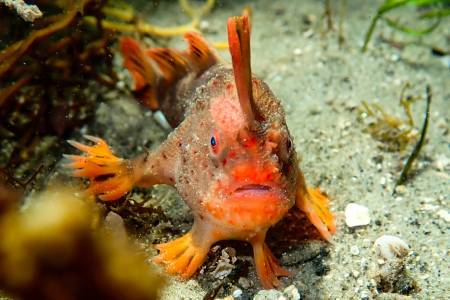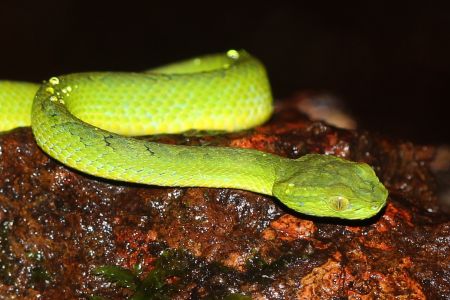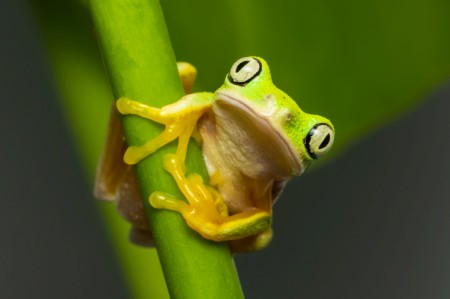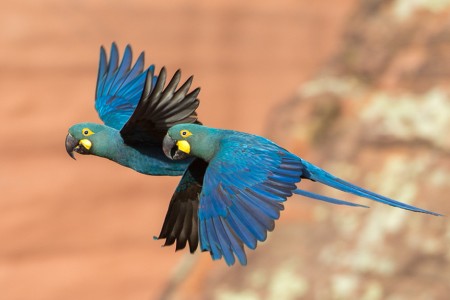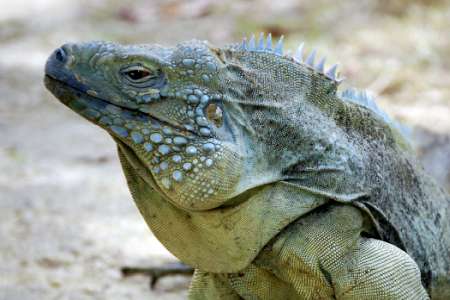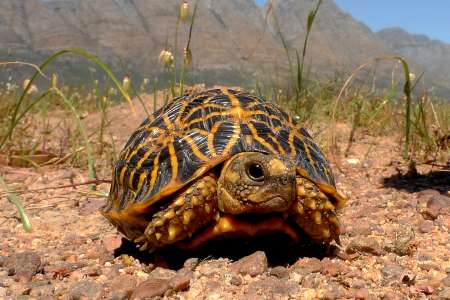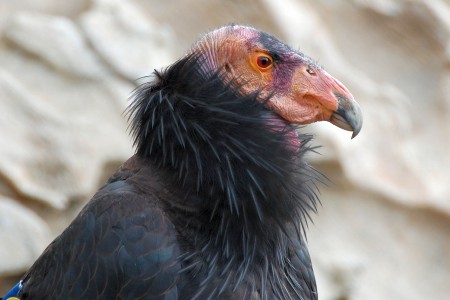
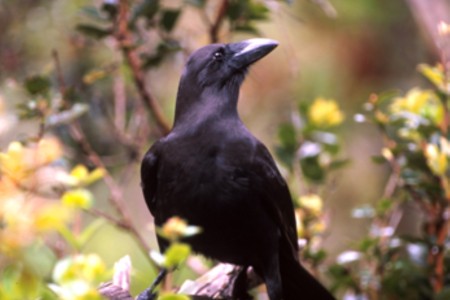
Hawaiian Crow
A Remarkably Important Species Now Missing from Its Wild Habitats

INTRODUCTION
The Hawaiian Crow (Corvus hawaiiensis) is often referred to by its native name, ‘Alalā. This unique crow holds a special place in the avian kingdom and is significant in Hawaiian culture and legends.
Scientific Classification
• Kingdom: Animalia
• Phylum: Chordata
• Class: Aves
• Order: Passeriformes
• Family: Corvidae
• Genus: Corvus
• Species: C. hawaiiensis
Appearance and Behavior
The Hawaiian Crow boasts a glossy, jet-black plumage. It measures about 19 inches (48 centimeters) in length and weighs about one pound (454 grams), giving it a sturdy build. Its dark, almost black eyes are complemented by a strong bill and a long, fan-shaped tail aiding its flight.
They are keenly intelligent and have been observed manipulating twigs and leaves to obtain insects and other small prey, thus displaying a high level of cognitive adaptability. This capacity for problem-solving and its ingenious use of tools for feeding purposes stand out in the bird world.
Contrary to the cawing of most of its relatives, the ‘Alalā produces a variety of unique vocalizations. These can range from a soft “caw” to more musical tones, which they use for communication, especially during mating and socially interacting within their group.
Habitat and Ecology
The Hawaiian Crow is a striking bird endemic to the Big Island of Hawaii that inhabits shrublands and both the dry and wet forests on the slopes of Mauna Loa and Hualālai. Their preference for native trees made them an essential seed disperser for various plant species. Normally living up to 18 years in the wild, their life expectancy can extend beyond 20 years under managed care conditions. The ‘Alalā is omnivorous, consuming a varied diet of fruits, seeds, eggs, carrion, young birds, and insects.
As part of their courtship behavior, the male ‘Alalā performs an array of vocal and physical displays to attract a mate. The Hawaiian Crow’s nesting season typically starts in March and extends through July. The female crow lays one to five greenish-blue eggs during a single breeding season. Often, only two survive. Only females brood and incubate the eggs.
A fascinating aspect of their breeding habits is their fierce dedication to their young. The male typically assumes a primary role in nourishing the chicks, and both parents actively feed and protect their offspring until they are around eight months old, when they can fend for themselves. This reflects the close-knit familial bonds that characterize this species.
Conservation Status
Due to a mix of habitat loss, disease, and invasive predators, the Hawaiian Crow’s population saw a sharp decline, and by 2002, the final pair of these birds in the wild had disappeared. In 2016, the IUCN’s Red List of Threatened Species classified the Hawaiian Crow as “Extinct in the Wild.” Efforts are underway in breeding programs for certain individuals still in captivity, with the aim of reintroducing them to their native habitats. Past efforts at reintroduction have not gone well, and surviving crows were recaptured and placed into zoo and captive programs.
THREATS TO HAWAIIAN CROWS
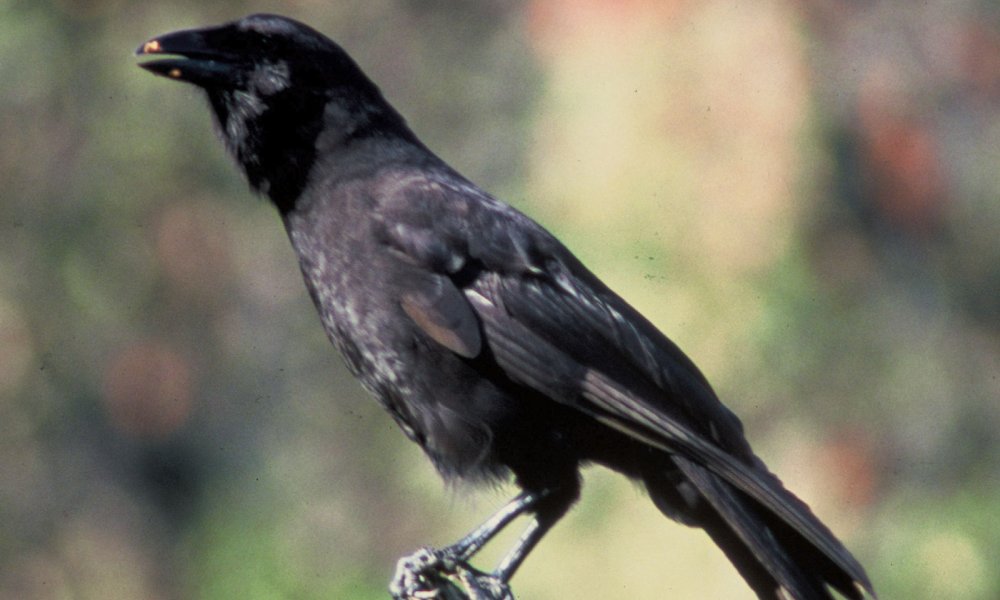
Habitat Destruction
The greatest threat that prevents the reintroduction of the Hawaiian Crow into the wild is habitat destruction. Urban expansion, agricultural development, and logging activities in the Hawaiian Islands have drastically reduced the natural habitats in which these birds formerly thrived. Fragmented habitats may not provide adequate resources for the ʻAlalā to survive, reproduce, and sustain healthy populations.
Human Interference
Direct and indirect human activities further compound the challenges facing the ʻAlalā. Road construction and other land development activities disturb the natural habitats of these crows. These disturbances shrink the living space available for reintroducing them into the wild, leading to fatal accidents, including collisions with vehicles or power lines. Littering and other human-derived pollution threaten their food sources and overall health.
Predators
The introduction of non-native species to the Hawaiian Islands had a significant impact on the ʻAlalā. Invasive species, whether plants that alter habitats or predatory animals that prey on the crows or their eggs, disrupt the ecosystem’s natural balance. Predators like rats, mongoose, and feral cats directly threaten the Hawaiian Crow and other species by preying on eggs, juveniles, and adult birds. The sole native predator of these crows was the Hawaiian hawk (‘io) (Buteo solitarius), whose extinction rating is near threatened.
Diseases
Disease is another considerable threat to the ʻAlalā. Diseases such as avian malaria and avian pox, both introduced to Hawaii, have severely impacted native bird populations. With its limited population, the Hawaiian Crow is particularly vulnerable when back in the wild. These diseases, along with others like the West Nile Virus disease, can result in fatalities or weakened birds that are more susceptible to other threats.
Climate-related Challenges
Although the Hawaiian Crows are not currently present in the wild, changes in climatic patterns will also affect them when they can fly free once again. Altered rainfall patterns, temperature shifts, and extreme weather events will impact their habitats and food availability and increase disease exposure. As the climate changes, it’s essential to consider its effects on the ʻAlalā and strategize conservation efforts accordingly. Sadly, this species is one of many in Hawaii that are under threat.
In conclusion, The Hawaiian Crow is undeniably a symbol of the rich biodiversity of the Hawaiian Islands. It is also one of the rarest birds and is nearly extinct. Numerous threats jeopardize its existence. By understanding these challenges, from habitat destruction to diseases, and by taking concerted actions for its protection, we can ensure the survival and flourishing of the ʻAlalā for future generations.
IMPORTANCE OF HAWAIIAN CROWS

Economic Implications of Crow’s Population Decline
Attempts to save the ʻAlalā and reintroduce it into the wild have incurred significant costs as funds are funneled into research, protection, habitat restoration, and reintroduction programs. These costs are often financed by international organizations, NGOs, and governments worldwide and inevitably impact taxpayers. One such project is the ʻAlalā Project, run by the Hawaiian government, which aims to return the crow to the wild. Additionally, enforcing protective measures like anti-poaching regulations, habitat preservation, and public education campaigns also carry associated costs. Global wildlife trade regulations necessitate further financial investments, emphasizing the shared responsibility of the worldwide community to conserve endangered species.
Effects on Local Ecosystems
The Hawaiian Crow’s disappearance from the wild has affected the balance of local ecosystems. Once a primary scavenger and seed disperser, the ʻAlalā facilitated the proliferation of native Hawaiian plants, thus supporting biodiversity. Their disappearance from the wild leads to a decline in the germination of specific plants, impacting the ecosystem’s overall health. Such ecological imbalances lead to the overpopulation of specific species and a decrease in others. Costly ecological restoration initiatives are required to address these changes in the overall ecosystem structures, highlighting the connection between removing just one species and broader environmental consequences.
Role in Climate Change Mitigation
Estimates are that tens of thousands or more Hawaiian Crows were once present centuries ago. They played a significant role in the ecosystem, aiding seed dispersal. The ʻAlalā promoted forest growth. Forests which absorbed carbon dioxide and helped to keep the climate on an even keel. In the intervening years, as their numbers dwindled and they were no longer present in the wild, the forest’s carbon sequestration capacity was lessened, which continues to impact climate change today. While deforestation is primarily due to human activities, it is also driven by the absence of essential seed dispersers like the Hawaiian Crow.
Impact on the Agricultural Sector
Another role ʻAlalā helped fulfill was in naturally controlling pests by feeding on farm products. Their decline resulted in rising populations of such pests and crop threats while contributing to higher agricultural costs. The latter came in the form of higher pest control costs, reduced yields, and increased prices for agricultural goods. This is illustrative of the interconnectedness between agriculture and biodiversity loss that has broader implications in view of the massive extinctions of other species coming during the rest of the 21st century.
Loss of Potential Ecotourism Opportunities
Given its unique nature and cultural significance, the Hawaiian Crow presents considerable ecotourism potential if it survives and is successfully reintroduced into the wild. Hawaii has long had a deserved reputation as a state with incredible biodiversity, but over time, the state has lost the most species in the United States. The reintroduction of the crows will involve creating environments that not only this species needs for survival. Others will also benefit.
Not only the Hawaiian Crow will be able to thrive, but many other species in the biodiversity web will as well. This will affect potential ecotourism revenue, increasing the local community’s economic benefits. Beyond immediate financial implications, ecotourism often supports community development, conservation initiatives, and sustainable eco practices. Therefore, A renewed ecotourism industry impacts local economies, global tourism interests, and conservation efforts.
The Hawaiian Crow stands as a reminder of the intricate relationships we have within our ecosystems and the cascading effects the loss of a single species can have on the broader environment.
HOW TO HELP HAWAIIAN CROWS
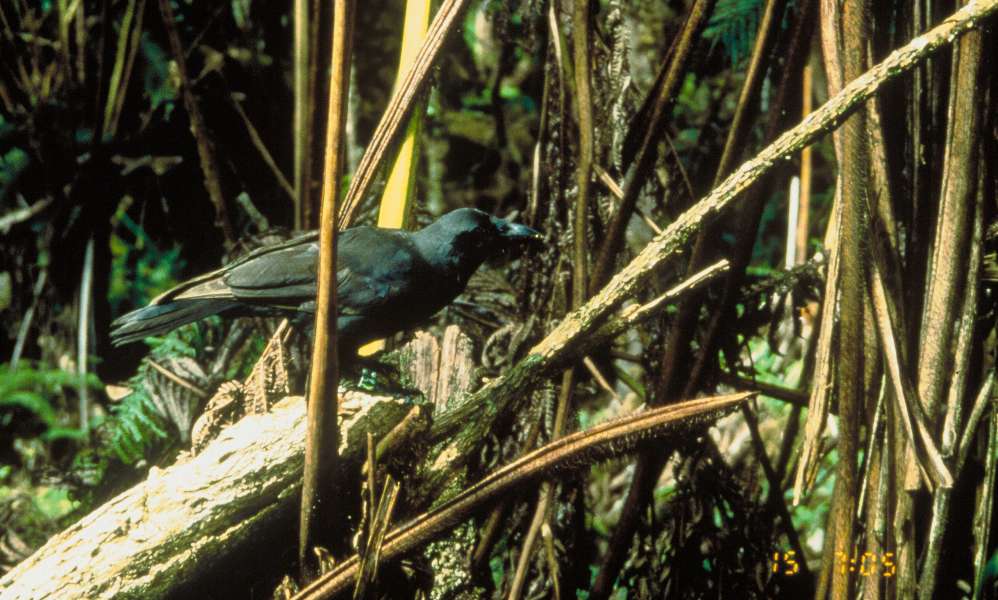
Understand Biodiversity Loss
The alarming decline in numerous species, including the Hawaiian Crow, is nature screaming to us about the global crisis of biodiversity loss. These real disruptions threaten the equilibrium of ecosystems and jeopardize even our very existence. Humanity’s actions often cause climate change, pollution, and worldwide biodiversity losses.
Educational Outreach and Advocacy
By first comprehending the intricate balance of biodiversity, the role of species like the Hawaiian Crow, and the potential consequences of their extinction, individuals can understand the seriousness of the situation. Using this knowledge, all of us can champion conservation efforts, using platforms ranging from social media to community discussions to pass along knowledge and solutions. These endeavors elevate awareness and advocate for effective measures to protect these birds and other species.
Support Local Communities
Local communities are often part of the problem and must be part of the solution. Directly connected with endangered species, such as the Hawaiian Crow, their knowledge of the species, collaboration, and involvement significantly impact conservation measures when addressing the problems. Sustainable practices, like eco-friendly farming and habitat preservation, integrated with local knowledge, can foster a habitat where humans and wildlife thrive. Education is crucial in bridging the gap between communities and conservation aims.
Support Ethical Tourism
Tourism, when channeled appropriately, can bolster conservation efforts. Ethical tourism initiatives, which prioritize both the environment and local customs, contribute to the survival of species like the Hawaiian Crow. Eco-tourism emphasizes activities with minimal disruption to wildlife and their habitats while providing economic benefits to local communities and raising biodiversity awareness among travelers.
Prevent Illegal Wildlife Trade
Extinct in the wild effectively puts this crow beyond the illicit wildlife trade, a global menace that endangers many species. A collective stand against such malpractices and strengthening of wildlife protection laws can curtail this industry’s demands. Public awareness about the implications of illegal wildlife trade can further intensify global measures against it. Hopefully, the Hawaiian Crow will one day again be found in the wild and not face this thread.
Support Conservation Organizations
Organizations focused on conservation play a crucial role in counteracting biodiversity losses. These groups are on the frontline in the battle against species declines and their restoration. Supporting these entities through donations or volunteering will amplify their efforts to protect species like the Hawaiian Crow and restore their habitats.
Adopt Environmentally Friendly Practices
Embracing green practices such as waste reduction, promoting renewable energy, and advocating for sustainable consumption can alleviate some of these impacts. These are measures each of us can individually take to aid in creating a healthier environment that ensures a brighter future for endangered species and humanity. One action critical to solving our problems is ensuring that our representatives know the problems and supporting solutions. While you and I should do our part, it will take global government actions to reign in the forces now endangering life on the planet. Please elect leaders who care!
Conclusion
Preserving endangered species like the Hawaiian Crow demands concerted actions from you, me, and every section of society. Through education, community involvement, responsible tourism, preventive measures against illegal trade, organizational support, green practices, and citizen science, we can shape a sustainable future for this bird and other species at risk and build a world where humans prosper.

